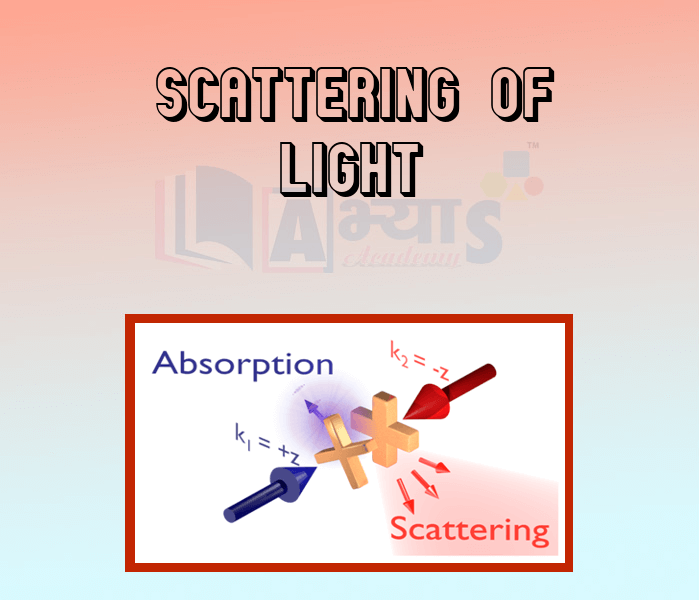Scattering of light










Scattering Of Light
Normally, when you switch on a torch, you do not see a beam of light traveling from the torch. Similarly, during the day you do not see the path of the sunlight as it illuminates things around you. However, you can see the path of light if there is dust, smoke or other small particles in the air. You might have seen the path of sunlight streaming into a room through a gap in the curtains. You might have also seen it coming down through gaps in trees in the early morning mist. In both cases, the path of the light is visible from different positions.
You know that light travels in straight lines. So, for us to see the path of light from different positions, light must be redirected in different directions by the particles in its path. The phenomenon in which a part of the light incident on a particle is redirected in different directions is called scattering of light.
When light falls on small particles, a part of it gets scattered in different directions. The rest of the light goes straight through. Do the following activity to see for yourself to see the process of scattering of light.
Activity :-
Place a glass of tap water in front of a paper screen or wall. Shine a laser pointer (or a small powerful torch) through the water. You will only see spots of light on the screen and on the walls of the glass.
In this activity, the scattering of light by particles of milk in its path enables you to see the path of the light. You are able to see the path because light from each point on it reaches your eyes. You will notice that the path of the light is visible from different positions around the glass. This means that milk particles send a part of the light in all directions. The rest of the light keeps moving in the original direction, making the spot of light on the screen.
A suspension of small particles in a medium is called a colloid. Milk is a colloid in which small fat particles are suspended in water. Smoke is a colloid in which ash particles are suspended in air. Fog and mist are colloids in which droplets of water are suspended in air. You will be able to see the path of a strong beam of light through all of these. The scattering of light by the particles in a colloidal solution is called the Tyndall effect. The scattered light makes the path of light visible. The activity above is also an example of the Tyndall effect.

Scattering of light involves _____________ | |||
| Right Option : D | |||
| View Explanation | |||
__________is the phenomenon due to which sky appears dark instead of blue to an astronaut | |||
| Right Option : A | |||
| View Explanation | |||
The sky looks blue on a clear,sunny day because of ___________________. | |||
| Right Option : B | |||
| View Explanation | |||
Students / Parents Reviews [10]
My experience with Abhyas is very good. I have learnt many things here like vedic maths and reasoning also. Teachers here first take our doubts and then there are assignments to verify our weak points.

Shivam Rana
7thMy experience was very good with Abhyas academy. I am studying here from 6th class and I am satisfied by its results in my life. I improved a lot here ahead of school syllabus.

Ayan Ghosh
8thBeing a parent, I saw my daughter improvement in her studies by seeing a good result in all day to day compititive exam TMO, NSO, IEO etc and as well as studies. I have got a fruitful result from my daughter.

Prisha Gupta
8thIt was good as the experience because as we had come here we had been improved in a such envirnment created here.Extra is taught which is beneficial for future.

Eshan Arora
8thA marvelous experience with Abhyas. I am glad to share that my ward has achieved more than enough at the Ambala ABHYAS centre. Years have passed on and more and more he has gained. May the centre flourish and develop day by day by the grace of God.

Archit Segal
7thIt was a good experience with Abhyas Academy. I even faced problems in starting but slowly and steadily overcomed. Especially reasoning classes helped me a lot.

Cheshta
10thI have spent a wonderful time in Abhyas academy. It has made my reasoning more apt, English more stronger and Maths an interesting subject for me. It has given me a habbit of self studying

Yatharthi Sharma
10thAbout Abhyas metholodology the teachers are very nice and hardworking toward students.The Centre Head Mrs Anu Sethi is also a brilliant teacher.Abhyas has taught me how to overcome problems and has always taken my doubts and suppoeted me.

Shreya Shrivastava
8thAbhyas Methodology is very good. It is based on according to student and each child manages accordingly to its properly. Methodology has improved the abilities of students to shine them in future.

Manish Kumar
10thMy experience with Abhyas academy is very good. I did not think that my every subject coming here will be so strong. The main thing is that the online tests had made me learn here more things.
